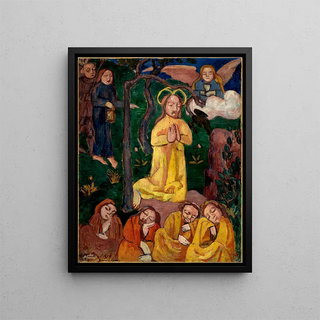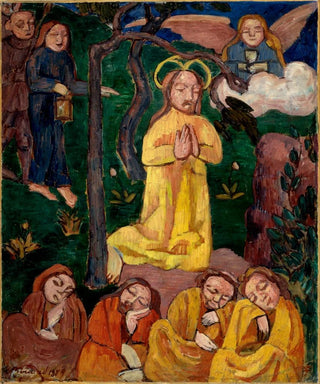Christ jaune - Émile Bernard | Art print


View from behind

Frame (optional)
Christ jaune - Émile Bernard – Captivating Introduction
In the rich and complex universe of art, certain works stand out for their ability to transcend time and provoke deep reflection. "Christ jaune" by Émile Bernard is one of those creations that, through its visual power and symbolism, invites the viewer to meditative contemplation. This piece, which belongs to the post-impressionist movement, evokes intense spirituality while playing with color and form. Through this art print, the artist manages to capture the very essence of his subject, transforming a religious representation into an exploration of human emotions.
Style and uniqueness of the work
Émile Bernard's style is characterized by a bold approach to color and a simplification of forms. In "Christ jaune," the color palette is dominated by warm, vibrant hues, with yellow occupying a central place. This color, often associated with divine light, gives the figure of Christ an almost mystical aura. The use of sharp contours and stylized shapes reflects an aesthetic pursuit that aims to be both modern and rooted in earlier pictorial traditions. Bernard, by moving away from classical representations, succeeds in creating a work that challenges and questions, while remaining faithful to a certain spirituality. This stylistic choice, blending abstraction and figuration, makes "Christ jaune" a unique work that continues to inspire and fascinate.
The artist and his influence
Émile Bernard, an emblematic figure of post-impressionism, played a crucial role in the evolution of art at the end of the 19th century. His work, marked by a quest for authenticity and truth, is set within a rapidly changing artistic context. Bernard does not merely reproduce the world as he sees it; he seeks to extract its essence, to reveal its mysteries. Influenced by masters such as Gauguin, he develops a style that combines personal sensitivity with technical innovations. His contribution to movements such as cloisonnism demonstrates his desire to redefine the boundaries of art. Through "Christ jaune," he manages to establish a dialogue between the sacred and the profane, between tradition and

Matte finish

View from behind

Frame (optional)
Christ jaune - Émile Bernard – Captivating Introduction
In the rich and complex universe of art, certain works stand out for their ability to transcend time and provoke deep reflection. "Christ jaune" by Émile Bernard is one of those creations that, through its visual power and symbolism, invites the viewer to meditative contemplation. This piece, which belongs to the post-impressionist movement, evokes intense spirituality while playing with color and form. Through this art print, the artist manages to capture the very essence of his subject, transforming a religious representation into an exploration of human emotions.
Style and uniqueness of the work
Émile Bernard's style is characterized by a bold approach to color and a simplification of forms. In "Christ jaune," the color palette is dominated by warm, vibrant hues, with yellow occupying a central place. This color, often associated with divine light, gives the figure of Christ an almost mystical aura. The use of sharp contours and stylized shapes reflects an aesthetic pursuit that aims to be both modern and rooted in earlier pictorial traditions. Bernard, by moving away from classical representations, succeeds in creating a work that challenges and questions, while remaining faithful to a certain spirituality. This stylistic choice, blending abstraction and figuration, makes "Christ jaune" a unique work that continues to inspire and fascinate.
The artist and his influence
Émile Bernard, an emblematic figure of post-impressionism, played a crucial role in the evolution of art at the end of the 19th century. His work, marked by a quest for authenticity and truth, is set within a rapidly changing artistic context. Bernard does not merely reproduce the world as he sees it; he seeks to extract its essence, to reveal its mysteries. Influenced by masters such as Gauguin, he develops a style that combines personal sensitivity with technical innovations. His contribution to movements such as cloisonnism demonstrates his desire to redefine the boundaries of art. Through "Christ jaune," he manages to establish a dialogue between the sacred and the profane, between tradition and
12,34 €






